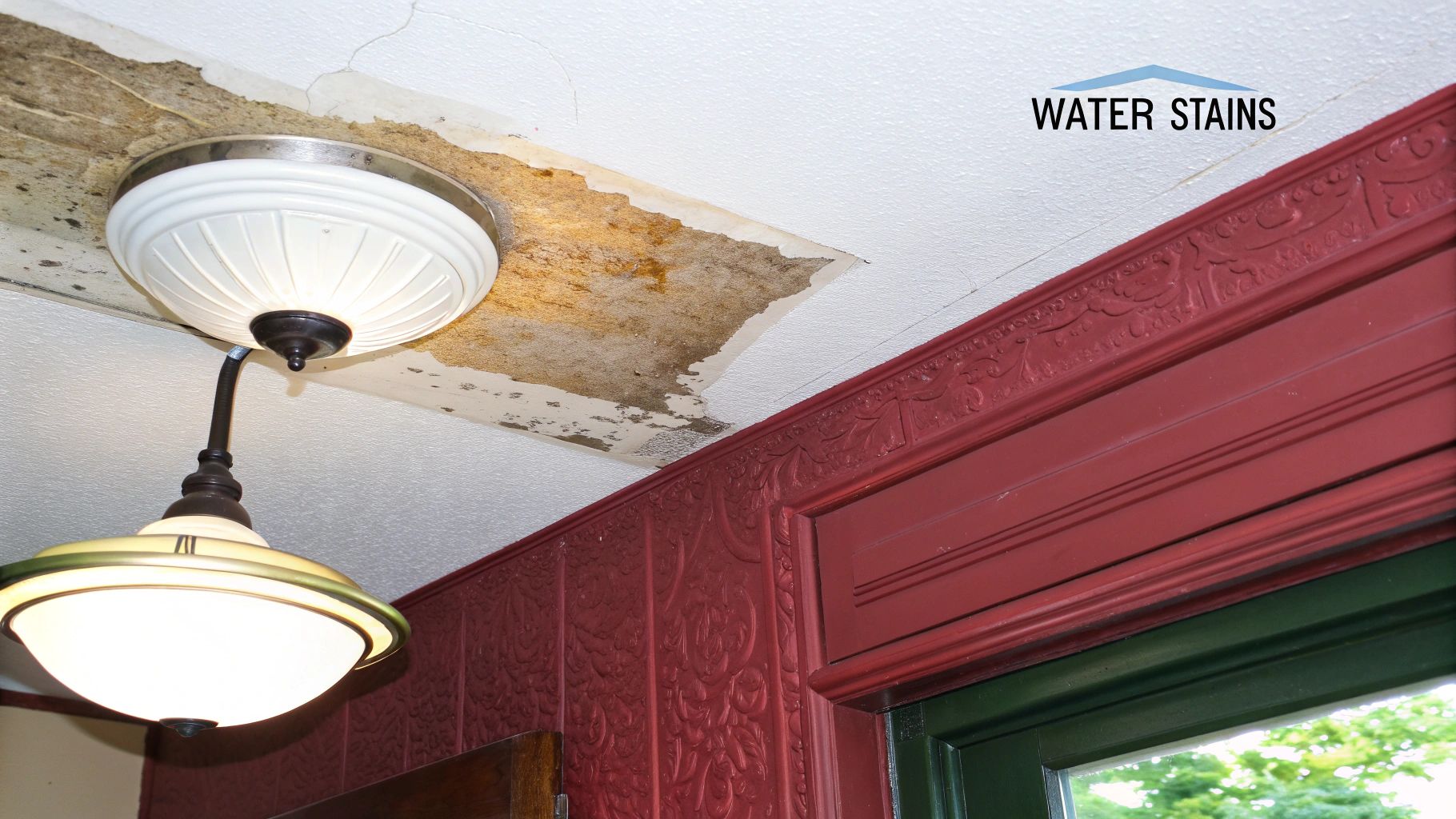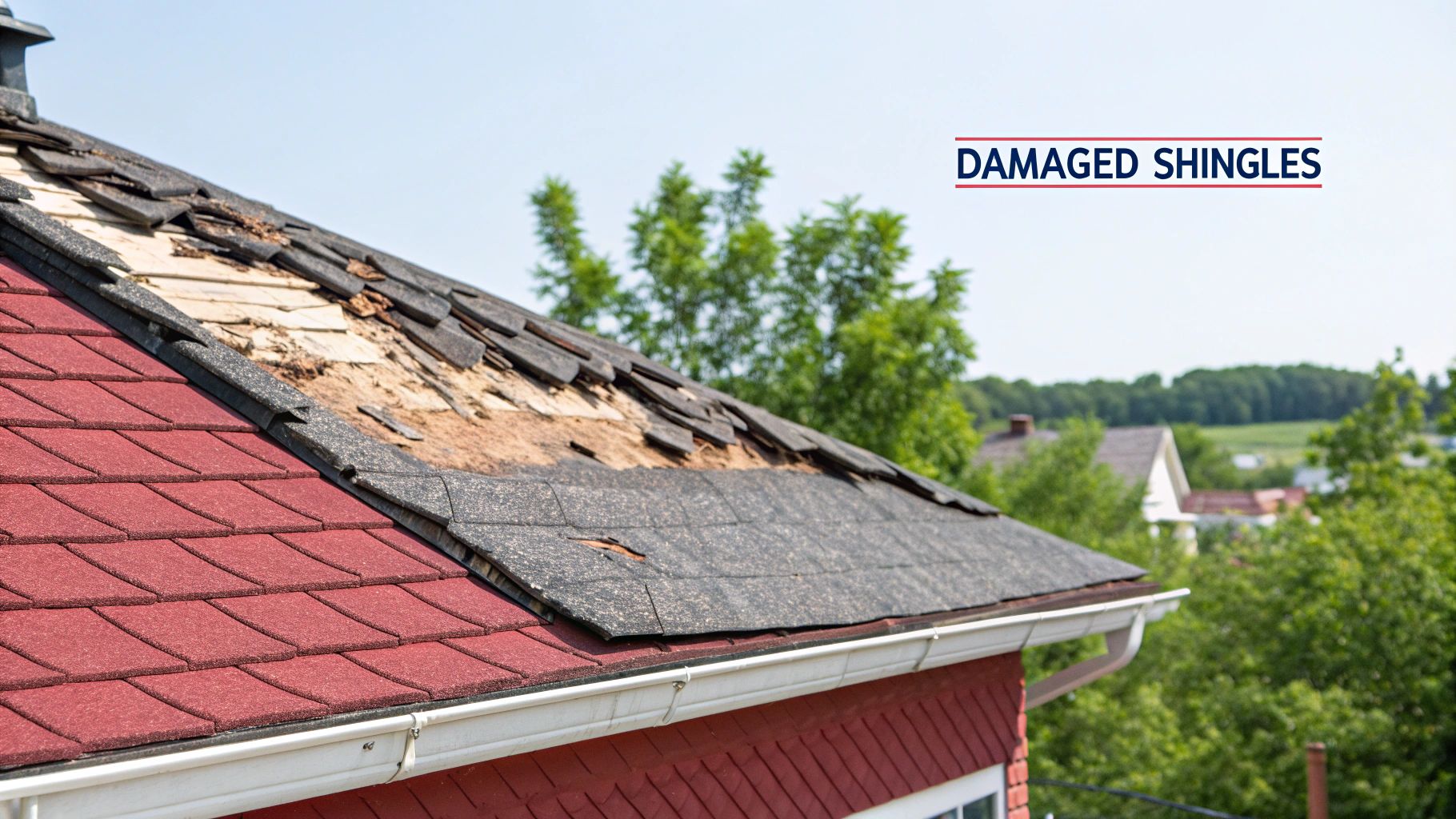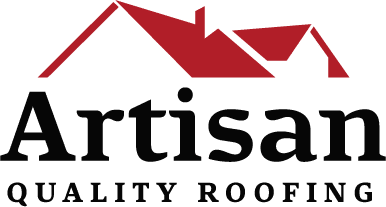Worried About a Leaky Roof?
A leaky roof can cause serious damage if left unchecked. This list shows seven important signs of a leaking roof. It helps you fix problems quickly and avoid expensive repairs. Identifying these signs early is crucial for protecting your Triangle-area home or commercial property. Learn to spot the telltale signs of a leaking roof, from water stains and damaged shingles to mold growth and sagging ceilings. This knowledge can save you time, money, and stress in the long run.
1. Water Stains and Discoloration on Ceilings and Walls
Water stains and discoloration on ceilings and walls are common signs of a roof leak. These marks indicate that water is getting through the roof and into the building. It’s important to address these stains quickly to avoid issues like mold, structural damage, and expensive repairs. This is essential for homeowners and property managers in Apex, Cary, Raleigh, and the surrounding areas.

Water Stains on Ceilings and Walls
Signs of a leaky roof often appear as brown, yellow, or rust-colored stains on ceilings and walls. These marks result from water seeping through the roof, carrying dissolved minerals, and depositing them on interior surfaces. Stains usually form in circular or oval shapes and can be found near ceiling fixtures, corners, or where walls meet ceilings. Water rings may also indicate leak progression over time. Homeowners in Durham, Chapel Hill, Morrisville, and nearby areas should watch for these signs. The weather in this region can change often.
Water stains are easy to see. They can show possible roof problems, even for people new to home care. This is particularly beneficial for homeowners in Holly Springs, Fuquay Varina, and nearby cities. Although the stain’s location doesn’t always match the actual leak source, it helps focus inspection efforts.
However, water stains have limitations. They might not show up right after a leak starts, especially if it’s small. Even after repair, stains can remain, requiring cosmetic fixes. Additionally, water can travel along structural elements, causing stains away from the leak’s origin.
Here are some tips for using water stains to detect roof leaks:
- Document and Monitor: Take photos to track stain changes over time, helping determine if the leak is active.
- Rainfall Check: Observe stains during and just after rain. Darkening or expanding indicates an active leak.
- Look for Patterns: Multiple stains in different areas may suggest broader roofing issues.
- Moisture Meter: Use this tool to find hidden water damage behind surfaces.
- Professional Inspection: Contact a roofing professional for thorough inspection if stains are observed.
Understanding water stains is useful for homeowners and property managers. Recognizing these early signs can help prevent extensive damage and maintain a safe indoor environment.
Dripping Water or Active Leaks
Dripping water or active leaks are clear indicators of a roof problem. They show a significant breach allowing water into the home, necessitating immediate attention. Finding and fixing these leaks is important to avoid more damage. This is especially true for owners in Apex, Cary, Raleigh, and nearby areas.
Active leaks manifest in several ways. You might observe visible water droplets falling from the ceiling, especially during periods of rain or snowmelt. Puddles forming on the floor directly beneath a suspected leak point are another clear indicator. Water running down interior walls, particularly near dormers, chimneys, or other roof penetrations, also signifies a compromised roof. The leaks often get worse during heavy rain. This shows a clear link between the roof’s weakness and the amount of water. For homeowners in Durham, Chapel Hill, and Morrisville, it’s important to notice these signs early. This can help prevent serious water damage.
Several factors contribute to active leaks. Damaged or missing shingles, cracked flashing around vents and chimneys, and deteriorated sealant around skylights are common culprits. Age, severe weather events, and improper installation can all compromise the integrity of your roof, leading to these breaches. Knowing the possible causes can help homeowners in Holly Springs, Fuquay Varina, and nearby areas. This way, they can fix problems early and stop leaks before they get worse. https://www.youtube.com/embed/v-jdt0PysG4
Active leaks clearly indicate a serious roofing problem, but they also offer some advantages. They make it easy to spot problem areas, directing repair efforts and simplifying insurance claims with visible evidence. This is especially useful for first-time homebuyers and real estate agents who need thorough inspections for informed decisions.
However, active leaks also mean severe damage, often requiring major repairs or complete roof replacements. Water entry can damage belongings, furniture, and interiors. Multiple leaks suggest widespread issues, complicating and increasing repair costs. Homeowners in Pittsboro, Sanford, and nearby areas should address leaks promptly to avoid rising expenses.
If you see signs of leaks, act immediately. Use buckets to catch water and protect floors. Turn off electricity in affected areas to avoid hazards. Document damage for insurance with photos and videos. Contact emergency roofing services for assessment and repairs. Cover furniture and electronics to reduce water damage. For those interested in eco-friendly options like cool roofs and solar readiness, a sound roof is essential. Quick action protects your home and long-term investment.
Damaged or Missing Shingles
Damaged or missing shingles are clear signs of a leaking roof. Shingles protect your home from weather elements. When they are damaged, this barrier is weakened, allowing water to enter and cause damage. Issues can range from small cracks to missing sections, increasing the likelihood of leaks. Spotting these signs early helps prevent costly repairs and maintains your home’s integrity. Ignoring damaged shingles can cause bigger problems like rot, mold, and structural damage. This makes roof maintenance very important for homeowners in Apex, Cary, Raleigh, and nearby areas.

Damage to shingles can result from several factors. Weathering, such as intense sun, heavy rain, and strong winds, is a major cause. As shingles age, they become brittle and less durable, increasing their risk of damage. Impact from falling debris, hail, or tree branches can also lead to cracks, splits, or dislodgment. Identifying damage types can help determine the cause and guide repair strategies. For example, curled shingles may indicate excessive heat, while missing shingles could suggest recent high winds.
Key indicators of shingle damage include visible cracks or splits, especially along edges or down the middle. Curled or lifted edges can happen because of wind or age. This can let water seep underneath and harm the layers below. Missing shingles expose roof sections, creating a direct path for water intrusion. Granule loss, where the protective coating wears away, exposes the underlying material, making shingles more prone to further damage. This loss is often seen as granules accumulating in gutters.
Finding roof leaks early is very important. It can save homeowners in Durham, Chapel Hill, Morrisville, and nearby areas a lot of money. Early detection allows for timely repairs, preventing further damage and costly replacements. Shingle damage is often visible from the ground using binoculars, providing a safe, convenient initial assessment. This is useful for first-time homebuyers and real estate agents needing a quick roof evaluation.
However, there are some downsides. While visual checks can reveal obvious damage, a full assessment often requires a professional roofing inspection. Experts can identify hidden issues, ensuring a thorough evaluation. Also, damage can worsen quickly during severe weather, making prompt repairs important. Multiple damaged areas may signal systemic roof failure, indicating a need for full replacement rather than patchwork repairs. This is important for homeowners in Holly Springs, Fuquay Varina, and nearby areas. It also matters for those in Pittsboro and Sanford. They want clear pricing and long warranties.
Regular roof inspections, especially after severe weather, are recommended to protect your home and prevent leaks. Use binoculars for a safe ground-level inspection, focusing on the signs mentioned. Check gutters for excessive granule build-up, a sign of shingle wear. If you see damage, schedule a professional inspection to assess the problem and get expert advice. Keeping spare shingles handy can help with quick temporary repairs. Top roofing companies like GAF, Owens Corning, and CertainTeed emphasize the need for regular maintenance and quick repairs. This helps to extend the life of your roof and protect your investment. For those interested in cool roofs, skylights, and solar readiness, maintaining roof integrity is key to maximizing energy efficiency.
4. Mold and Mildew Growth
Mold and mildew growth is a clear sign of a leaking roof and can thrive in damp, dark conditions from water leaks. Even a small leak can eventually lead to mold and mildew, often indicating a problem. Ignoring these signs can cause structural damage and health hazards. It is important to check for mold and mildew when assessing roof condition. This is especially true in places like Apex, Cary, and Raleigh. The humidity in these areas can make the problem worse.

Mold and Mildew Signs on Roof
Mold and mildew often show up as dark spots, fuzzy patches, or a musty smell. They are typically dark green, black, or brown, with a fuzzy or thread-like appearance. These patches are common in damp areas like corners, ceiling edges, attics, or on wooden beams. Homeowners in the Triangle area, like Durham, Chapel Hill, and Morrisville, should look for these signs to protect their homes.
While mold and mildew are concerning, they can indicate moisture issues before causing major damage. A musty smell can warn of a leak before visible signs appear, which is vital for budget-conscious homeowners. Identifying mold helps locate leaks, allowing for focused repairs, benefiting property managers and HOAs managing multiple properties.
However, mold and mildew can be health hazards, causing allergies and respiratory issues. Protective gear is necessary during inspections. Mold suggests prolonged moisture exposure, possibly requiring professional remediation, increasing repair costs. Therefore, transparent pricing and long warranties are crucial for homeowners.
Tips:
- Regular Inspections: Check attics and ceilings for mold, especially after storms.
- Fix Leaks Promptly: Address leak sources quickly with professional help.
- Control Moisture: Use dehumidifiers and improve ventilation.
- Wear Protective Gear: Use masks and gloves when inspecting or cleaning mold.
- Seek Professional Help: Consider professional testing and remediation for extensive growth.
For those interested in green options like cool roofs, a solid, leak-free roof is essential. Ignoring mold can undermine these investments.
Sagging or Drooping Ceiling Areas
A sagging ceiling is a clear sign of a leaking roof and water damage. It occurs when water collects above the ceiling, causing the materials to bow. This issue signals significant damage and requires urgent attention to prevent further harm.
Identification:
- Visible Sagging: Look for dips or curves in the ceiling.
- Cracks: Cracks may radiate from sagging areas.
- Softness: A spongy texture indicates water saturation.
- Paint Issues: Bubbling or peeling paint or wallpaper suggests moisture.
Pros of Early Detection:
- Visible Indicator: Prompts quick action.
- Prioritizes Repairs: Highlights urgent repair needs.
- Prevents Collapse: Timely action can prevent dangerous collapses.
Cons:
- Indicates Severe Damage: Significant water damage may affect structural integrity.
- Extensive Repairs Needed: Repairs may involve replacing ceiling sections and reinforcing structures.
- Safety Hazards: A severely sagging ceiling requires immediate evacuation.
Examples:
- Sagging drywall or plaster.
- Warped drop ceiling tiles.
Actionable Tips:
- Evacuate Severely Sagging Areas.
- Avoid Pushing Sagging Areas Back Up.
- Protect Belongings Below.
- Contact a Structural Engineer.
- Document Damage for Insurance.
Addressing sagging ceilings requires professional expertise. A qualified contractor can check and fix the problem. This is important for first-time homebuyers and those who want eco-friendly options.
Damaged Flashing Around Roof Penetrations
Damaged flashing around roof penetrations is a common sign of leaks. This area needs careful inspection as it is a weak point in roof protection. Homeowners should be vigilant, especially in the Triangle area.
Flashing Issues:
- Cracked or Bent Metal: Weather can cause metal flashing to crack or warp.
- Rust or Corrosion: Rust weakens metal, leading to leaks.
- Separated Joints: Deteriorating sealant can cause separation.
- Damaged Sealant: Cracked or missing sealant indicates compromised flashing.
Benefits of Addressing Flashing Issues:
- Localized Repairs: Damage is often confined, making repairs manageable.
- Prevents Major Leaks: Regular maintenance can extend roof life.
Drawbacks:
- Requires Ladder Access: Inspection needs safe access.
- Multiple Failure Risks: Many penetrations need monitoring.
- Professional Installation: Proper sealing often needs skill.
Examples:
- Chimney flashing separation.
- Deteriorating vent boots.
- Skylight flashing failure.
Tips:
- Annual Inspection: Check flashing for wear.
- Re-caulk Gaps: Use appropriate sealant for minor repairs.
- Replace Corroded Flashing: Prevent costly damage by replacing corroded parts.
- Ensure Proper Overlap: Secure new flashing correctly.
- Upgrade Materials: Consider more durable options.
Understanding flashing’s role helps protect investments and prevent expensive repairs.
Increased Energy Bills and Poor Insulation Performance
A leaking roof can lead to higher energy bills and poor insulation. Water-damaged insulation loses effectiveness, increasing energy consumption and costs. Recognizing this subtle sign can prevent extensive damage.
Indicators:
- Rising Energy Bills: Unexplained increases, especially after storms.
- Uneven Temperatures: Rooms with varying temperatures suggest compromised insulation.
- Drafts: Air leaks from ceilings indicate insulation issues.
- Frequent HVAC Use: A struggling HVAC system signals insulation problems.
Benefits:
- Early Detection: Identifies problems before visible damage.
- Quantifiable Evidence: Compare bills for signs of issues.
Challenges:
- Indirect Sign: Requires further investigation to confirm leaks.
- Multiple Causes: Aging systems or windows can also increase bills.
- Indicates Hidden Damage: Professional assessment may be needed.
Tips:
- Compare Bills: Check current bills against past ones.
- Inspect Insulation: Safely check the attic for moisture or damage.
- Use Thermal Imaging: Identify heat loss areas.
- Monitor Humidity: Look for unusual increases.
- Schedule Energy Audits: Identify inefficiencies and improve home efficiency.
Recognizing the link between energy bills and roof leaks helps homeowners protect their homes and save on repairs.
7 Key Signs of a Leaking Roof Comparison
| Sign | Implementation Complexity | Resource Requirements | Expected Outcomes | Ideal Use Cases | Key Advantages |
|---|---|---|---|---|---|
| Water Stains and Discoloration | Low | Basic inspection tools, moisture meter | Visible discoloration indicating leaks | Early detection of water intrusion inside | Easy to identify; indicates general leak location |
| Dripping Water or Active Leaks | Low | Buckets, electrical safety measures | Immediate evidence of roof breach | Emergency detection during/after precipitation | Clear proof; easy documentation |
| Damaged or Missing Shingles | Moderate | Binoculars, professional roof inspection | Visible external roof damage | Routine external roof inspections | Preventable damage if caught early |
| Mold and Mildew Growth | Moderate | Protective gear, mold testing, dehumidifiers | Identification of moisture and health risks | Persistent moisture problems with odor or spots | Indicates leaks before structural damage |
| Sagging or Drooping Ceiling Areas | High | Structural assessment, possible engineer | Serious structural compromise | Severe water damage with visible deformation | Prioritizes urgent repair; prevents collapse |
| Damaged Flashing Around Penetrations | Moderate | Ladder access, sealants, professional repair | Localized, repairable leak sources | Roof penetrations like chimneys, vents, skylights | Specific damage area; preventive maintenance |
| Increased Energy Bills and Poor Insulation | Moderate | Energy bills, thermal imaging, moisture meters | Early sign of hidden moisture damage | Unexplained heating/cooling cost increases | Early indicator; quantifiable through bills |
Don’t Wait, Take Action: Protect Your Home Today!
Identifying a leaking roof is vital for safeguarding your home and investment. Look out for water stains, damaged shingles, mold, and sagging ceilings. These signs help you tackle issues before they worsen. Ignoring even minor leaks can lead to expensive repairs, structural damage, and health risks from mold. No matter where you are in the Triangle, it’s important to know these signs. This includes places like Apex, Cary, Raleigh, Durham, and Chapel Hill. They help keep your property’s value and safety. Spotting and fixing leaks early is your best defense against serious damage. Act promptly to prevent a small leak from becoming a big problem.
Artisan Quality Roofing is here to help with all roof leak issues. We serve the Triangle area, including Holly Springs, Fuquay-Varina, Pittsboro, and Sanford, offering free inspections and expert solutions. Visit Artisan Quality Roofing to schedule your free inspection and protect your roof for the long term.



